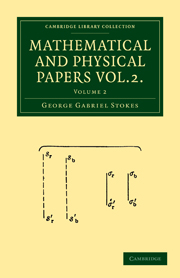Book contents
- Frontmatter
- Contents
- Notes on Hydrodynamics. III. On the Dynamical Equations
- On the constitution of the Luminiferous Ether
- On the Theory of certain Bands seen in the Spectrum
- Notes on Hydrodynamics. IV. Demonstration of a Fundamental Theorem
- On a difficulty in the Theory of Sound
- On the Formation of the Central Spot of Newton's Rings beyond the Critical Angle
- On some points in the Received Theory of Sound
- On the perfect Blackness of the Central Spot in Newton's Rings, and on the Verification of Fresnel's Formula for the intensities of Reflected and Reflacted Rays
- On Attractions, and on Clairaut's Theorem
- On the Variation of Gravity at the Surface of the Earth
- On a Mode of Measuring the Astigmatism of a Defective Eye
- On the Determination of the Wave Length corresponding with any Point of the Spectrum
- Discussion of a Differential Equation relating to the Breaking of Railway Bridges
- Notes on Hydrodynamics, VI. On Waves
- On the Dynamical Theory of Diffraction
- On the Numerical Calculation of a class of Definite Integrals and Infinite Series
- On the Mode of Disappearance of Newton's Rings in passing the Angle of Total Internal Reflection
- On Metallic Reflection
- On a Fictitious Displacement of Fringes of Interference
- On Haidinger's Brushes
- Index
On Haidinger's Brushes
Published online by Cambridge University Press: 07 September 2010
- Frontmatter
- Contents
- Notes on Hydrodynamics. III. On the Dynamical Equations
- On the constitution of the Luminiferous Ether
- On the Theory of certain Bands seen in the Spectrum
- Notes on Hydrodynamics. IV. Demonstration of a Fundamental Theorem
- On a difficulty in the Theory of Sound
- On the Formation of the Central Spot of Newton's Rings beyond the Critical Angle
- On some points in the Received Theory of Sound
- On the perfect Blackness of the Central Spot in Newton's Rings, and on the Verification of Fresnel's Formula for the intensities of Reflected and Reflacted Rays
- On Attractions, and on Clairaut's Theorem
- On the Variation of Gravity at the Surface of the Earth
- On a Mode of Measuring the Astigmatism of a Defective Eye
- On the Determination of the Wave Length corresponding with any Point of the Spectrum
- Discussion of a Differential Equation relating to the Breaking of Railway Bridges
- Notes on Hydrodynamics, VI. On Waves
- On the Dynamical Theory of Diffraction
- On the Numerical Calculation of a class of Definite Integrals and Infinite Series
- On the Mode of Disappearance of Newton's Rings in passing the Angle of Total Internal Reflection
- On Metallic Reflection
- On a Fictitious Displacement of Fringes of Interference
- On Haidinger's Brushes
- Index
Summary
It is now several years since these brushes were discovered, and they have since been observed by various philosophers, but the author has not met with any observations made with a view of investigating the action of different colours in producing them. The author's attention was first called to the subject, by observing that a green tourmaline, which polarized light very imperfectly, enabled him to see the brushes very distinctly, while he was unable to make them out with a brown tourmaline which transmitted a much smaller quantity of unpolarized light. He then tried the effect of combining various coloured glasses with a Nicol's prism. A red glass gave no trace of brushes. A brownish yellow glass, which absorbed only a small quantity of light, rendered the brushes very indistinct. A green glass enabled the author to see the brushes rather more distinctly than they were seen in the light of the clouds viewed without a coloured glass. A deep blue glass gave brushes of remarkable intensity, notwithstanding the large quantity of light absorbed. With the green and blue glasses, the brushes were not coloured, but simply darker than the rest of the field.
To examine still further the office of the different colours in producing the brushes seen with ordinary daylight, the author used a telescope and prism mounted for shewing the fixed lines of the spectrum.
- Type
- Chapter
- Information
- Mathematical and Physical Papers , pp. 362 - 364Publisher: Cambridge University PressPrint publication year: 2009First published in: 1883
- 1
- Cited by



